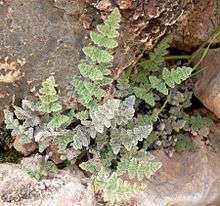Cheilanthoideae
Cheilanthoideae is one of the five subfamilies of the fern family Pteridaceae.[1][2] The subfamily is thought to be monophyletic, but some of the genera into which it has been divided are not, and the taxonomic status of many of its genera and species remains uncertain, with radically different approaches in use as of December 2019.
| Cheilanthoideae | |
|---|---|
 | |
| Myriopteris parryi | |
| Scientific classification | |
| Kingdom: | Plantae |
| Clade: | Tracheophytes |
| Class: | Polypodiopsida |
| Order: | Polypodiales |
| Family: | Pteridaceae |
| Subfamily: | Cheilanthoideae W.C.Shieh |
| Genera | |
| Synonyms | |
|
Cheilanthaceae B.K.Nayar | |
Phylogenic relationships
The following phylogram shows a likely relationship between Cheilanthoideae and the other Pteridaceae subfamilies.[3]
| Pteridaceae |
| ||||||||||||||||||||||||
Although subfamily Cheilanthoideae itself is thought to be monophyletic, many of the genera into which it has been divided (including Cheilanthes, Doryopteris, Notholaena, and Pellaea) have been shown to be polyphyletic.[4]
Genera
The division of the subfamily Cheilanthoideae into genera and species remains uncertain as of December 2019. Christenhusz et al. (2011), the Pteridophyte Phylogeny Group classification of 2016 (PPG I), and the November 2019 version of the Checklist of Ferns and Lycophytes of the World (World Ferns 8.11) agree on the following genera:[1][2][5]
- Adiantopsis Fée
- Aleuritopteris Fée
- Argyrochosma (J.Sm.) Windham
- Aspidotis (Nutt. ex Hooker) Copel.
- Astrolepis D.M.Benham & Windham
- Bommeria E.Fourn.
- Calciphilopteris Yesilyurt & H.Schneid.
- Cheilanthes Sw. (nom. cons.)
- Cheiloplecton Fée
- Doryopteris J.Sm. (nom. cons.)
- Gaga Pryer, F.W. Li & Windham
- Hemionitis L.
- Lytoneuron (Klotzsch) Yesilyurt
- Mildella Trev.
- Myriopteris Fée
- Notholaena R.Br.
- Ormopteris J.Sm.
- Paragymnopteris K.H.Shing
- Pellaea Link (nom. cons.)
- Pentagramma Yatsk., Windham & E.Wollenw.
- Trachypteris André ex Christ.
Some other genera that have been included in the subfamily (or split off from genera included in the subfamily) are:[1][2][5]
- Allosorus Bernh. – not included by Christenhusz et al. (2011); accepted in PPG I; World Ferns 8.11 includes it in Aleuritopteris, saying that it was wrongly typified
- Baja Windham & L.O.George – accepted by World Ferns 8.11
- Mickelopteris Fraser-Jenk. – accepted by World Ferns 8.11
- Oeosporangium Vis. – included in Allosorus in PPG I; re-accepted by World Ferns 8.11
- Parahemionitis Panigrahi – accepted by Christenhusz et al. (2011) and PPG I; considered a synonym of Paragymnopteris by World Ferns 8.11, which places the species Parahemionitis cordata in the monotypic genus Mickelopteris
- Pteridella Mett. ex Kuhn – accepted by Christenhusz & Chase (2014);[6] considered a synonym of Pellaea by World Ferns 8.11
Other sources take a radically different approach. As of December 2019, Plants of the World Online places all of the possible genera of the Cheilanthoideae in the single genus Hemionitis.[7] (Parahemionitis is treated as a synonym of Acrostichum,[8] a member of a different subfamily.)
References
- Christenhusz, Maarten; Zhang, Xian-Chun & Schneider, Harald (2011). "A linear sequence of extant families and genera of lycophytes and ferns". Phytotaxa. 19: 7–54. Retrieved 2013-08-11.
- PPG I (2016). "A community-derived classification for extant lycophytes and ferns". Journal of Systematics and Evolution. 54 (6): 563–603. doi:10.1111/jse.12229.
- Schuettpelz, Eric; Pryer, Kathleen M.; Ranker, Tom A. & Haufler, Christopher H. (2008). "Chapter 15 Fern phylogeny" (PDF). In Ranker, Tom A. & Haufler, Christopher H. (eds.). Biology and Evolution of Ferns and Lycophytes. Cambridge University Press. pp. 417–467. ISBN 978-0-521-87411-3. Retrieved 2019-12-31.
- Schuettpelz, Eric; Schneider, Harald; Huiet, Layne; Windham, Michael & Pryer, Kathleen M. (2007). "A molecular phylogeny of the fern family Pteridaceae: Assessing overall relationships and the affinities of previously unsampled genera" (PDF). Molecular Phylogenetics and Evolution. 44: 1172–1185. doi:10.1016/j.ympev.2007.04.011. Archived from the original (PDF) on 2008-02-21.
- Hassler, Michael & Schmitt, Bernd (November 2019). Checklist of Ferns and Lycophytes of the World. 8.11. Retrieved 2019-12-31.
- Christenhusz, Maarten J.M. & Chase, Mark W. (2014). "Trends and concepts in fern classification". Annals of Botany. 113 (9): 571–594. doi:10.1093/aob/mct299. PMC 3936591. PMID 24532607.
- "Hemionitis L." Plants of the World Online. Royal Botanic Gardens, Kew. Retrieved 2019-12-31.
- "Parahemionitis Panigrahi". Plants of the World Online. Royal Botanic Gardens, Kew. Retrieved 2019-12-31.